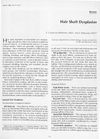TLDR Hair dysplasias involve various hair disorders causing fragility, breakage, and poor hair adhesion.
The chapter on hair dysplasias discussed various clinical and morphological characteristics of these conditions. It highlighted atypical pili torti, often associated with Menkes’ syndrome, and other dysplasias like pili canaliculi and woolly hair. Pseudomonilethrix was described as a rare autosomal dominant defect causing hair fragility. Trichorrhexis invaginata involved a ballooning and chaliced deformation of the hair shaft. Trichothiodystrophy was noted as a complex syndrome resulting from low sulfur content in hair, leading to specific dysplasia and hair breakage at distal ends, causing trichoptilosis and trichorrhexis nodosa. Loose anagen hair was identified as a dysplasia due to poor adhesion of the hair shaft to the follicle.
 19 citations
,
March 1988 in “International Journal of Dermatology”
19 citations
,
March 1988 in “International Journal of Dermatology” Hair shaft dysplasias are abnormal hair conditions that can be inherited or acquired and may signal other health issues, with limited treatment options available.
 19 citations
,
March 1988 in “International Journal of Dermatology”
19 citations
,
March 1988 in “International Journal of Dermatology” Hair shaft dysplasias are abnormal hair conditions that can be inherited or acquired and may signal other health issues, with limited treatment options available.
 68 citations
,
August 2012 in “Journal of the American Academy of Dermatology”
68 citations
,
August 2012 in “Journal of the American Academy of Dermatology” Dermatoscopy is a useful tool for diagnosing hair disorders and can help choose samples for more detailed analysis.
 26 citations
,
July 2019 in “Dermatology and Therapy”
26 citations
,
July 2019 in “Dermatology and Therapy” The conclusion is that genetic testing is important for diagnosing and treating various genetic hair disorders.
 59 citations
,
June 2008 in “Journal of The American Academy of Dermatology”
59 citations
,
June 2008 in “Journal of The American Academy of Dermatology” The article explains the genetic causes and symptoms of various hair disorders and highlights the need for more research to find treatments.
 November 2019 in “Harper's Textbook of Pediatric Dermatology”
November 2019 in “Harper's Textbook of Pediatric Dermatology” Understanding normal hair growth and loss in children is key to diagnosing and treating hair disorders.




